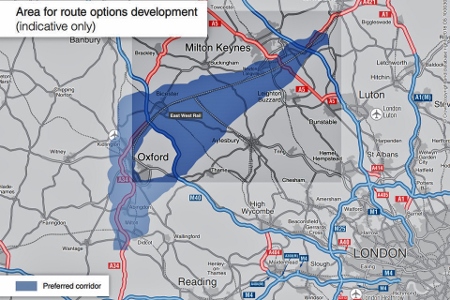Legal challenge launched against government’s Oxford to Cambridge Expressway
On 27/09/2018 At 12:07 pm
Category : Missed a ThameNews story?, More News, Thame news
Responses : No Comments
TODAY (27/09/18), Berks Bucks and Oxon Wildlife Trust (BBOWT) and the Wildlife Trust for Bedfordshire, Cambridgeshire and Northamptonshire Wildlife Trust (BCNWT) have initiated a challenge to the process whereby Highways England and the Department for Transport selected ‘Corridor B’ for the Oxford to Cambridge Expressway and associated ‘Growth Corridor’ which could include up to one million new homes.
Earlier this year the two Wildlife Trusts made a submission to the Highways England consultation in which we detailed our concerns about the potential environmental impact of the three ‘corridors’ that were then being proposed, and made it clear that we consider ‘Corridor B’ to be the worst option.
After making this submission, and participating in environmental stakeholder groups with Highways England, we are disappointed that the government does not seem to have considered the environment in equal balance with economic factors.
Highways England failed to commission a Strategic Environmental Assessment (SEA) or a Habitats Regulation Assessment (HRA) as part of the process of selecting a Corridor. This is required under European Law for schemes that impact on the environment such as this. This means the true environmental effect has not properly been considered and the public has been denied the opportunity to fully scrutinise the comparative economic, societal and environmental impacts of the options.
This failure forms the basis of the legal challenge that we are embarking upon today. A pre-action protocol letter has been sent to the Secretary of State for Transport, Rt Hon Chris Grayling, challenging the government’s failure to commission an SEA or HRA and lack of effective public participation in the decision. If there is no satisfactory response, a claim will be made in the High Court before the end of October, after which the Court will consider the case’s merits. It is anticipated that there will be a Judicial Review hearing before the end of 2018.
Estelle Bailey, Chief Executive Officer of BBOWT, said, ‘Earlier this year we told Highways England that the potential impact on biodiversity of Corridor B is so serious that the route should have been discounted entirely, and pressed them to conduct a Strategic Environmental Assessment. They ignored us. Today we challenge the Secretary of State for Transport to address the government’s failure to take the environment into account in its decision’.
The Environmental Law Foundation is supporting this action, with Leigh Day Solicitors and barristers from Francis Taylor Building providing pro-bono advice. Their support demonstrates the strong legal foundation for this case. We would like to acknowledge the work that Barrister Merrow Golden and the Horton cum Studley Action Group have undertaken up to this point with regard to challenging the lack of an SEA.
Tessa Gregory, Partner at Leigh Day, said, ‘It is important that decision-makers listen to local organisations and local people and imperative that environmental effects are properly assessed at the appropriate stage. Corridor selection is precisely the time for such strategic assessment to be carried out so that the environmental impacts of a plan or programme, such as the Expressway Corridor, are understood. It is disappointing that the Secretary of State has pressed ahead without such assessment, despite consultation submissions from the Wildlife Trusts’.
BBOWT’s most serious concerns are for the designated sites and nature reserves in Cothill Fen, Oxford Meadows, the Otmoor Basin, Upper Ray Valley and Bernwood Forest. If the A34 is widened west of Oxford the increase in traffic and pollution could affect sensitive areas such as Oxford Meadows, Cothill Fen and Wytham Woods. An alternative route around the south and east of Oxford would potentially impact on important areas for nature conservation including Bagley Wood, Sandford Brake, Brasenose Wood and Shotover Hill.
The area east of Oxford is characterised by a mosaic of ancient woodlands, species-rich grassland, open water, scrub and hedgerows, which form part of the former Royal Hunting Forest of Bernwood. It is one of the most undisturbed and wildlife-rich areas of Buckinghamshire. Upper Ray Valley and ancient woodlands in the vicinity of Calvert, including Finemere Wood, would also be at risk.
Corridor B also crosses the River Ouzel to the south east of Milton Keynes. The river and its associated habitats must be taken into account in the exact route choice following corridor selection. The Greensand Ridge includes a network of wildlife-rich sites including King’s and Baker’s Woods and Heaths. Rushmere Country Park, a popular public open space, would also be affected. Where the corridor moves towards the M1 around Woburn, there are woodlands which contain Wavendon Heath Ponds. Any route within this corridor would need to avoid these biodiversity hotspots.
SOURCE: Contributed (Press release)


